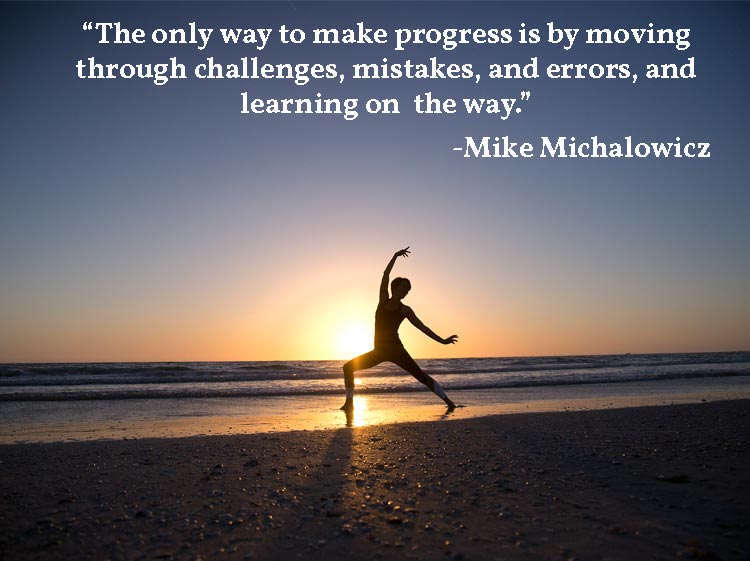 If you ever wondered what your clients thought about your programs, you’re not alone. If you’re like me, you want to continually gain trust and respect in your community while offering the best services possible. In order to do this, though, you must get feedback from your students. This involves asking the right questions at the right times. In this article, you’ll learn 10 tips to craft a great feedback form (which will save you making the same mistakes over and over again, often impeding your business growth for months and years to come).
If you ever wondered what your clients thought about your programs, you’re not alone. If you’re like me, you want to continually gain trust and respect in your community while offering the best services possible. In order to do this, though, you must get feedback from your students. This involves asking the right questions at the right times. In this article, you’ll learn 10 tips to craft a great feedback form (which will save you making the same mistakes over and over again, often impeding your business growth for months and years to come).
Over the past year, I have attended several trainings of various lengths—from 2-hour workshops to multi-week trainings. Each yoga business had a unique way of collecting information from me, as a participant. Some sent out an email within 24 hours of attending the event. Others waited a week or two to gather input about the training. One personally called me to see if I had any questions, and another failed to ask at all.
In all cases, I found small areas in which each class or training could have improved. This seems like a no-brainer since my job is to help yoga businesses enhance their communication and efficiency. These combined experiences lead me to write this article in the first place. You want your community to give you the cold, hard truth. You want their praise, and you also want their suggestions to make your services better. So set your ego aside and get ready to embrace constructive feedback as a way to refine your skills.
Photo Credit: Raw Pixel
GOALS OF FEEDBACK
Crafting a great feedback form is a powerful way for you to hear what your clients actually want. If their needs match your vision, and if you’re willing to whole-heartedly meet those desires, your business can skyrocket.
Thus, getting feedback from those you serve has many benefits. You get to:
- Know more about the people you serve—how they think, feel, and make decisions for their well-being.
- Ensure your classes, workshops, and trainings get better each time.
- Improve slowly, often without making huge changes to your operation. This saves you time and energy.
- Satisfy, and exceed, the expectations for your clients. This naturally leads them to leave raving reviews about their experience with you.
And, when you craft a great feedback form, you’ll also increase the completion rates. This will amplify all the benefits above. Here are the 10 tips you’ll want to consider:
(1) ASK FOR FEEDBACK
This may seem obvious since you’re reading about how to craft a great feedback form. Yet as I mentioned above, not everyone reaches out to their community. Use this as an opportunity to build trust with your students. Let them know you’re human and willing to improve. This will not only deepen your relationship with them, it can also establish long-lasting camaraderie.

Photo Credit: Ember and Earth Photography
(2) CUSTOMIZE YOUR FORM
Each of your events, products and services are unique. You will want to customize your feedback form to reflect those differences. Instead of using a one-size-fits-most form, develop specific ones for each event or service. Said another way, you want to design your feedback form to get the information you really want and need about your business.
And since your business has many different aspects, the questions you ask about each one will vary. For example, the form you send to new students to your studio will be very different than the one you use to gauge the success of a weekend arm-balance intensive.
The best part is that you will get more accurate feedback by customizing each form. This is especially true for clients who have worked with you for years and attend various types of events over time.
(3) WRITE WELL
The way you write the content of your feedback form matters just as much as what it looks like and when you send it. Here are some tips to write well in your feedback form:
Be succinct with your questions
It’s best to make your questions clear and to-the-point. Decide which information matters most to you, then ask questions around those topics.
Proof-read your copy
Read your questions two or three times to ensure they are clear. Better yet, have someone else read them to make sure others will understand them. And above all, make sure your grammar and spelling are correct, too!
 Use the Goldilocks principle
Use the Goldilocks principle
When you craft a great feedback form, you don’t want it to be too short, or too long… you want it to be just the right length. Basically, you want to ask as few questions as possible while still getting the information you need. This will change based on the experience or service or product. Your audience can also determine this.
Keep in mind that the more invested your community, the more likely they are to spend time answering in-depth questions. And, the quality of questions will also affect the length of your feedback form. You just want to find that sweet spot to get as much feedback as possible without overwhelming your clients or making the survey too long.
Speak to your audience
The words and tone of each feedback form can be different for each segment of your community. First-time students will likely know less about yoga than the graduates of your 200-hr yoga teacher training, so you’ll want to use language each will understand.
The more invested your audience, the more likely they are to spend the time answering in-depth questions.
A quick story about writing clear questions:
One training I attended had morning classes taught by one teacher the entire week. Then, the evening class had rotating guest teachers. When asked to rate my satisfaction with the practice sessions for the week, there was only one question on their feedback form.
This put me in a mental dilemma since the morning and evening classes were very different.
The morning sessions were long and detailed. The time flew by and the experience was on point to the theme of the training. I would have rated those as 5, or excellent.
The evening sessions, on the other hand, felt disconnected from the rest of the learning material. And, even though we had been seated for long hours of the day during the training, we still had numerous seated postures in the restorative evening classes. I would have preferred to be flat on the floor, so I would rate those a 1 or 2, more on the dissatisfied end of the scale.
Since the feedback survey only gave me one chance to comment on this aspect of the classes, I ended up averaging to a 3. This gave no learning opportunity for the yoga business leading the training. Likely other participants did the same thing.
The takeaway here: Be specific as possible when writing your questions to get the feedback you actually need and want!
(4) MAKE IT USER-FRIENDLY
This might also seem like a common sense tip, but you’d be surprised at how many feedback forms don’t keep the end-user (your clients) in mind. Many are too difficult to access, or the instructions are too complex. When this happens, you lose your audience.
Here are some basic principles for user-friendly feedback forms. They are:
Make navigation easy
Include lots of white space so the form looks clean. Essentially, you want to craft a great feedback form that is visually appealing and free of clutter. You can also change font color or size in different sections to make the form easy to navigate.
Create optional sections
The goal is to get every client to fill out the entire form. But let’s be real. That’s just not going to happen. So, make the sections of your feedback form optional so you get as much information from each student as possible.
Use a logical flow
Just like a river has a natural progression, so should your feedback form. While each part of your yoga business is unique, the flow for each aspect might be slightly different. However, each experience has a beginning, middle, and end. So you could use time as your logical flow. Or, you could go from big concepts and narrow them down into details. In any case, use the most logical sequence possible to prevent confusion, frustration, and abandonment of your form.

Use a consistent rating scale
While you might have written your questions well and made your instructions easy-to-understand, you also want the numerical system you use to be consistent. For example, always use 1 as your low rating and 5 or 10 as your high. Many forms change the number systems mid-way and your client will be forced to use more brainpower to answer your questions. This can make them rush through the form, give you inaccurate feedback, or skip the section entirely.
An important reminder:
Even yogis spend a lot of time on their mobile devices these days, so check the settings on your feedback form via your phone or tablet before sending it out to your community. This will double-check it’s user friendly for all.
(5) INCLUDE OPEN-ENDED QUESTIONS
You often have blind spots when creating a product or service, and unless you have gone through the experience as a client, you probably are missing important ways to improve. Thus, you want to leave open-ended comment boxes to learn about these unexpected aspects. Maybe you ask:
- What surprised and delighted them most about the experience?
- Which aspects fell short of their expectations?
- If they were to coordinate the experience for others, what would they have done differently?
The most important thing is that you give them space to use their own words. This will help you see your company through new and different eyes.
(6) INCENTIVIZE FORM COMPLETION
Time is a very valuable resource. Since you are asking your clients to give some of their time for your benefit (aka information about your yoga business), it can help to sweeten the deal in this trade. Maybe you offer an incentive to them for completing your feedback form. You could offer a discounted rate on their next class, workshop, or monthly membership. You might have an e-book, or video series or something already created that is of low-cost to you that you could give away for free. Or, you could even raffle off a prize to one lucky winner. Such prizes might include a free studio tank top or local goodie from a brand with whom you’ve generated a partnership.
Ideally, you want honest and prompt feedback from your students. Giving something away as a trade for their time and energy can ensure this is the case.
The flipside of incentives:
When students can fill out a feedback form anonymously, you can often get more accurate information. If names or emails need to be attached to your survey in order to win a raffle prize, this could dilute the constructive criticism you receive. There are lots of online survey companies nowadays, and there might be a way to remain anonymous to your yoga business while still being entered in a drawing.

Photo Credit: Ember and Earth Photography
(7) REQUEST FEEDBACK IMMEDIATELY
Timing matters, and you want to leverage the power of timing to get the best feedback possible from your students. Research shows that endings often have the greatest emotional impact. So, you want to send your feedback form immediately while that experience is fresh in their mind.
I’ve been to workshops where a feedback form is sent a week, or even a month after the event. If you do this, your clients are likely back in the swing of their regular lives. This is not to say they didn’t like the experience with you. It just means your response rate will greatly drop and the information you receive will be diminished.
Running a year-long teacher training?
Consider sending shorter feedback forms after each module as part of the training process. At the end of the year, students will have likely forgotten details about each segment. Plus, you demonstrate the importance of crafting a great feedback form on their own!
(8) SET A TIME FRAME FOR FEEDBACK
While we’re talking about timing, it’s essential to give a time frame to receive feedback on the form. Have you had a project without a deadline and just let it linger on your to-do list for months? Well, if you don’t provide a time frame for your community to complete your feedback form, they will likely put it off, too. Their schedules fill up with higher priorities and the free time they thought they had to complete your survey is now booked.
You want to give them enough time to fill it out– or book time in their schedule to do so — but not wait so long that the feedback form gets forgotten. I suggest a 5-7 day window to receive great feedback. Just make sure you give this timeline clearly (and in bold)!

Photo Credit: Jeanne Rouillard
(9) SEND A REMINDER
Life gets busy, and since you took the time to craft a great feedback form, you really want your students to complete it. Send them a reminder about halfway through the timeframe you created. This will put you back on their radar and let them know their opinion is really important to you.
You can also send one final reminder 24 hours before the deadline. Plus, when you sweeten the deal with something free, it gives them greater incentive to participate.
(10) SAY THANK YOU
There are so many great ways you can express appreciation for your clients. One of my all-time favorite ways to do this is to simply say “Thank you!” Once they complete the feedback form, you can send them to a landing page that says this directly.
What could step this up a notch?
Send your client a personalized card or call them directly to get more details about their experience. You might want more clarity on their answers or to further thank them for their participation in the event. Recently I visited a studio in which the owner herself made a follow-up call to inquire about my experience (even though I didn’t even take her class). This was almost shocking to me, but so refreshing. While I don’t live in that area, I sure as heck would return for a second visit if I did. It made me feel noticed in such a fast-paced, digital world.
So if you have the manpower to follow up in this way, I highly suggest it! You never know what great insights you will gain from extending your inquiry beyond the feedback form to more personalized contact. Be speedy in this response, though, like within 24 or 48 hours. This will again show you are competent in your yoga business and really care about the feedback you are receiving.
PUTTING IT TOGETHER
You must blend art and science when you craft a great feedback form for your students. You want it to be just the right length and contain clear, concise questions that will help your yoga business improve. In finding this sweet spot, you’ll gain trust and respect from your community. And, you’ll ensure the needs of your students are being met with flying colors!
Take Action Now:
- Pull out your existing feedback forms and see how well you’re doing in the above 10 areas. This might mean you have to find them in your digital file folders and print them out on paper to review them.
- If you want a second eye on your material, consider working with us to improve your communication








Leave A Comment